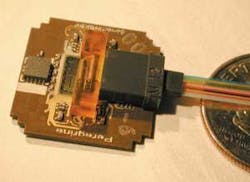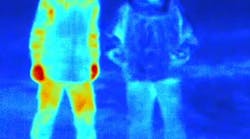By John McHale
SAN DIEGO - Engineers at Peregrine Semiconductor in San Diego developed a prototype optical transceiver for harsh environments that will work with next-generation field programmable gate arrays (FPGAs) at 2.5 gigabit per channel per second.
“Peregrine has developed a low-cost, manufacturable approach to building parallel optic transceivers based on the flip-chip bonding of Gallium Arsenide VCSEL [vertical-cavity surface-emitting laser] and PIN arrays onto CMOS-on-sapphire ICs,” says Charlie Kuznia, director of photonic products at Peregrine.
Peregrine is doing this for a space program, says Chuck Tabbert, director of space and defense products at Peregrine. It is also based on work performed for a DARPA small business innovative research project.
For military applications the device would be for anything with sensor suite such as unmanned aerial vehicles, high-resolution imaging, and radar, Tabbert says. The transceiver also would also be viable for the F-35 Joint Strike Fighter, which has a fiber backplane as opposed to copper, Kuznia says.
Fiber has advantages over copper because of its light weight, flexibility, and electromagnetic interference (EMI) immunity, and uses only one cable. Fewer cables offer better system-wide connector reliability, Tabbert says.
The first product was a 4+4 transceiver with each channel operating at 2.5 gigabits per second. The second-generation product-the PE97203/PE87203 ultra-small-form-factor Transceiver-is a prototype that addresses several technical hurdles in building parallel optical transceivers for harsh environment space and military aerospace applications.
The prototype offers optical power monitoring with a silicon detector that monitors each VCSEL to maintain constant power and extinction ratio over the -40 to 100 degrees Celsius temperature range and VCSEL aging.
The combination of increased receiver dynamic range (the ratio of saturation/sensitivity) and relatively tight tolerance on transmitted power enables operation over fiber links with greater than 15 decibels of loss.
All materials were chosen to survive IR solder reflow. The transceiver pigtail can be removed during solder assembly.
Since the transceiver monitors the average power at both ends of the fiber link, the BIT network can calculate the cable plant link loss, and VCSEL threshold and slope efficiency is continually monitored for signs of aging.
Finally, the assembly sequence has been proven in Peregrine’s previous product and there is a straightforward path to manufacturing more than 2,000 units per month with end-module prices less than $1,000, Kuznia says.
Peregrine’s prototype transceiver IC contains all transceiver circuitry, four VCSEL drivers and four receivers, Kuznia says. “The VCSEL and PIN devices are flip-chip bonded on the IC, precisely aligned to fiducial marks on the IC. The IC is flip-chip bonded to an interposer substrate, which routes IC signals to BGA contacts. Each flip-chip step is sealed with an underfill material with low moisture uptake.”
The prototype is also much smaller than the original, around the size of a 25-cent coin, Tabbert says.
The transceiver meets Fibre Channel performance for 1x and 2x data rates, Kuznia says. The receiver has saturation level above +1.5 dBm and sensitivity below -17.5 dBm.
“To take advantage of the available range of operational receiver optical power, we can raise the maximum transmitted power to be closer to the receiver saturation limit,” Tabbert says. “Considering we must reserve 2 dB for test fixture uncertainty, operation over a 15 dB link loss is feasible.
“Can we raise the specification for the transmitted power? Most VCSEL-based transceivers incorporate more than 2.5 dB of attenuation to allow VCSEL operation at higher currents (increasing performance) while remaining below the max transmit power spec, he continues.
“The upper limit on transmitter power is an artifact of telecom receiver design methodology and pre-2000 eye-safety limits,” Kuznia explains. “Telecom receivers sacrifice saturation levels to achieve better sensitivity, since low-loss short links do not exist in the long distance telecom scenario. Introduced in 2000, the Class 1M limit sets a safety standard for viewing light without a magnification aid. The Class 1M limit for the Peregrine transceiver is +0.8 dBm per channel.
Integrated photodetector (IPD) monitor silicon lateral photodiodes are implemented in the IC process to monitor the VCSEL output power on each channel. A microcontroller algorithm regulates power on a per-channel basis.
“We are developing a ‘dual-loop’ algorithm that maintains constant average power and extinction ratio over temperature,” Kuznia says. “This eliminates extensive temperature testing during production and end-of-life penalties seen in look-up table approaches.”
The automatic power control of each laser channel is key to low test and production costs and extended temperature ranges, Tabbert says.
The device has a total ionizing dose resistance of 100 kilorads, and has single-event-upset resistance at 20 MeV-cm2/mg, and has error detection and correction built in, Kuznia says.
Peregrine is building gull-wing prototypes for space customers who are averse to ball grid array packaging, Tabbert says. In February the company will have a beta prototype ready to go, he adds.
It will be a standard product available off the shelf, but will be tweaked depending on the radiation requirements of each customer, Kuznia says.
For more information visit www.psemi.com.




